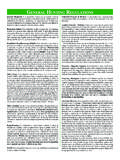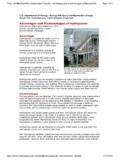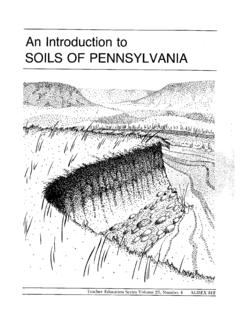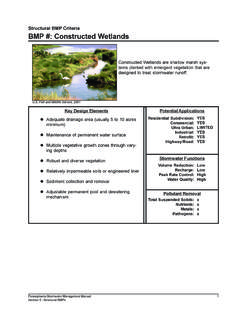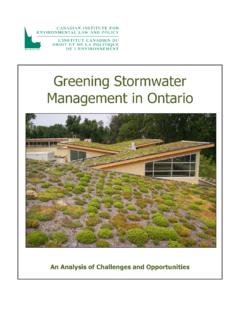Transcription of The Role of Trees in StormwaterFactsheet
1 The Role of Trees & Forests in Healthy Watersheds Managing stormwater , Reducing Flooding, and Improving Water Quality P ennsylvania contains almost 83,000 miles of rivers and streams, ranging from small trickles to large rivers. These waterways are important because they provide water for people, farms, and industries; provide habitat for many kinds of wildlife and fish; and also provide us with great places to fish, swim, and boat. As our landscape changes, it begins to have an impact on stream health. What we do on or to the land affects both the quantity (volume) and quality (pollutant levels) of the water in our streams and lakes.
2 The land area through which any water moves, or drains, to reach a stream is called a watershed. As we begin to remove forest canopy and replace it with roads, parking lots, driveways, homes, patios, pools (impervious surfaces) and even grass, we immediately have impact on watersheds and receiving streams (or lakes). With the increased amount of impervious surfaces, water runs off the land, traveling on the surface towards the streams. As this storm water runoff travels to the streams it collects pollutants and increases speed.
3 The changes to the landscape, not only increase the volume of water that goes to the stream, it also shortens the amount of time it takes the water to get to the stream. These increased or peak flows cause water to move quickly to the streams. This leads to flooding, stream bank erosion, widening of streams, sediment deposited in streams, a loss of fish habitat, and decline in water qual-ity. In Pennsylvania there are over 12,200 miles of polluted streams and over 3,000 miles of streams that are im-paired by storm water runoff.
4 So how do we protect water quality and our streams as watersheds change? Trees and forests play an incredible role in reducing storm water in several ways and removing or filtering pollutants that would otherwise wind up in our waterways. Canopy Interception and Infiltration Forests filter and regulate the flow of water, in large part due to their leafy canopy that intercepts rainfall, slowing its fall to the ground and the forest floor, which acts like an enormous sponge, typically absorbing up to 18 inches of precipitation (depending on soil composition) before gradually releasing it to natural channels and recharging ground water.
5 In a North Carolina Watershed study (Kays, 1980) the mean soil infiltration rate went from in/hr to in/hr when a site was con-verted from forest (duff layer on soils) to suburban turf. Other studies (Bharati et al. 2002) have found similar results when comparing hourly infiltration rates and soil bulk density of forested areas with crops and grazed pasture. Average interception of rainfall by a forest canopy ranges from 10-40% depending on species, time of year, and precipitation rates per storm event. In urban and sub-urban settings a single deciduous tree can intercept from 500 to 760 gallons per year; and a mature evergreen can intercept more than 4,000 gallons per year.
6 Even young, small Trees help. In a recent Forest Service study a single small tree (callery pear) that was only 9 years old, was able to intercept 58 gallons of storm water from a inch rain event (67% of the rain that fell within the canopy). A study in the 1980 s of Dayton, Ohio s existing tree canopy found that storm water runoff was reduced by 7% and could be increased to 12% through plant-ing more Trees . In a more recent UFORE Hydro study conducted by the USDA Forest Service of the Toby Creek Watershed (a suburban area of Wilkes-Barre), 54% tree canopy cover was able to reduce storm water runoff by 11%.
7 One Forest Service Researcher has stated that planting large canopy Trees over impervious surfaces, such as a parking lot or street has much greater impact on reducing storm water (up to 8 times greater) because it works to reduce peak flows in urban settings. Trees Consume stormwater Trees and forests absorb and use tremendous amounts of water for growth, thereby consuming storm water. A single mature oak tree can consume (transpire) over 40,000 gallons of water in a year. In Pennsylvania forests, an average of 24 inches of the annual 40 inches of rainfall is taken up by Trees through evapotranspiration (movement of water from the ground through the tree and leaves, evaporating back into the environment).
8 That evapo-transpiration also serves to cool and modify surrounding summer temperatures. If the forest is removed or har-vested, evaporation drops to 14 inches and stream flow increases to receive 26 inches of the annual 40 inches of precipitation. So, just the removal of forests can have an impact on streams in the watershed. Pollutant Removal and Phytoremediation Plants, especially woody plants, are very good at removing nutrients (nitrates and phosphates) and contaminates (such as metals, pesticides, solvents, oils and hydrocarbons) from soil and water.
9 These pollutants are either used for growth (nutrients) or are stored in wood. In one study, a single sugar maple growing roadside removed 60mg of cadmium, 140mg of chromium, 820mg of nickel, and 5200mg of lead in a single growing season (Coder, 1996). Studies in Maryland showed reductions of up to 88% of nitrate and 76% of phosphorus after agricultural runoff passed through a forest buffer. In comparison, studies of residential lawns have shown overuse of chemical fertilizers (over 100 million tons applied to lawns annually) and synthetic pesticides (80 million pounds applied to lawns annually 10 times the rate per acre used by farmers Yale graduate study).
10 Excess nutrients from lawns and agricultural fields is one of the largest sources of non-point pollutants that is impacting water quality in our streams, rivers, lakes and the Chesapeake Bay. Parking lots, one of the fastest growing land uses, have become a major cause of water quality and stream degradation. Non-Point Source pollutants such as petroleum hydrocarbons, nitrates, and heavy metals (cadmium, copper, lead, and zinc) from brakes and rusting automobiles all wash into our water ways. Even a small rain storm (less than.)



